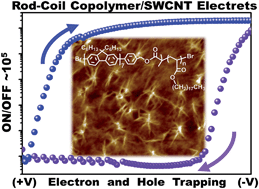Nonvolatile memories using the electrets of conjugated rod-coil block copolymer and its nanocomposite with single wall carbon nanotubes†
Abstract
We report high performance pentacene based organic field-effect transistor (OFET) memory devices using the electrets of conjugated rod-coil block copolymers, poly[2,7-(9,9-dihexylfluorene)]-block-poly(stearyl acrylate) (PF-b-PSA) and their nanocomposites with single-wall carbon nanotubes (SWCNT). The self-assembled PF-b-PSA electret, with the PF nanorods covered by the crystalline PSA block, exhibited a distinct hole-trapping capability due to the high electrical field generated in the confined dimension of the nanorods. Thus, it could effectively reduce the current leakage and stabilize data retention with a large memory window (35.8 V) and a high ON/OFF ratio over 104 s. Furthermore, the memory window of the device was further improved to 49.2 V by wrapping well-dispersed single-wall carbon nanotubes (SWCNT) in PF-b-PSA. The bundles of PF nanorods along the SWCNT effectively capture electrons and maintain retention characteristics similar to that of the PF-b-PSA device. This study demonstrated that the self-assembled conjugated rod-coil block copolymers and their nanocomposites could act as charge-storage electrets for high performance OFET memory devices through the precise morphology control.


 Please wait while we load your content...
Please wait while we load your content...